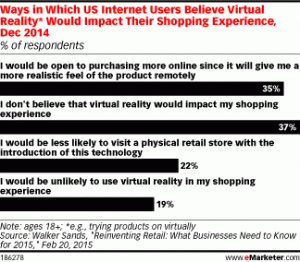With headsets like the Oculus Rift, HTC Vive and Sony’s PlayStation VR (formerly Project Morpheus) all releasing in 2016, companies are bracing themselves for the potential realities of virtual reality, and how to best use the technology to promote their brand. VR could change the way we work, play, and interact with each other. According to a report from the consulting group Tractica, VR spending by consumers could reach $21.8 billion by 2020. Meanwhile, Digi-Capital, a different consulting group, released a report that ups the spending estimate to a whopping $150 billion by 2020 – upending mobile. Meanwhile, Business Insider predicts that 26.5 million virtual reality headsets will be sold over the next five years.
Whether it’s augmenting reality with digital information, or being transported to all-new spaces (like inside a food sorting machine) with virtual reality, it’s clear that different brands want to be associated with this growing form of cutting edge technology. The reason being that these experiences provide opportunities for consumers to engage with products like never before.
Movies and TV shows seem ready to take advantage of what virtual reality has to offer with the experiences like the Paranormal Activity: Ghost Dimension VR Demo, The Hunger Games VR experience, and the John Wick VR game among others. Virtual reality lets fans engage in fantastic worlds that they see in movies, making the link between the two an obvious one.
The sense of engagement and immersion makes for an unforgettable experience that companies want associated with their brands. Red Bull is promoting an air race experience, where participants take part in the high-speed motorsport by strapping on an Oculus Rift headset. It’s all the thrill of being in the cockpit without needing a pilot’s license. Landmark Entertainment is looking to get a Virtual World’s Fair online by 2017, where consumers can experience and shop from spaces around the globe without leaving their homes. Similar experiences were mentioned by CEO Mark Zuckerberg when Facebook purchased Oculus VR for $2 billion last year. An article from TechCrunch states that “VR can and will revolutionize brand/consumer interaction.”

However, we can’t forget that virtual reality is a completely untested field, and its widespread adoption is far from guaranteed. Even with research like the December 2014 report published by Walker Sands (via eMarketer), which indicates that “two-thirds of U.S. internet users said they would be interested in virtual reality, and 63% said such technologies would change the way they shop.”
The report further states that 35% of people would change over to online shopping instead of going to brick and mortar stores because virtual reality would give them “a more realistic feel of a product.” However, that is counter-balanced by how 37% of respondents “couldn’t imagine the technology having an effect on their shopping experience.”
eMarketer also mentions research done by Economist Intelligence that states that marketers aren’t ready to for virtual reality, as both virtual and augmented reality ranked at the bottom of the list of impactful marketing trends by 2020. But that hasn’t stopped companies like The North Face (an outdoors clothing retailer), Mountain Dew and Merrell footwear from producing their own virtual experiences (shown above) to promote their products. Even The New York Times has partnered with Google on a virtual reality project by packing a cardboard VR viewer in with the November 8th print edition, so that subscribers can watch the a virtual reality film called The Displaced, using smartphones.
Ironically, it looks like the best way for to get more consumers comfortable with virtual reality technology and online shopping is by having VR experiences in the stores themselves, further contributing to the obsolescence of brick-and-mortar retail. Fashion company Tommy Hilfiger recently announced a VR shopping experience, superior to what can be had online, that will roll at select store locations. Furthermore, some of the movie VR tie-ins mentioned earlier can only be experienced at select movie theaters.
Virtual reality has a ways to go before we can expect to see mass adoption, but marketers are already seeking creative way to engage with audiences and associate brands with memorable experiences.

